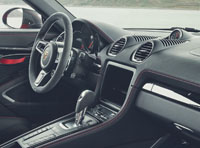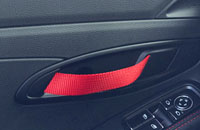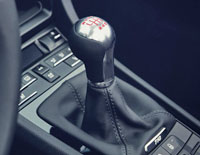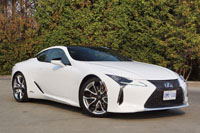
Luxury automakers have some models that sell in high volumes, thus providing much needed income and profits, others they’d like to do better, and one or two image vehicles that increase brand visibility and hopefully cause prospective buyers to choose something more affordable and/or practical in the lineup. Once in a while a vehicle achieves both objectives, but such isn’t the case with the stunning new Lexus LC 500 and LC 500h.
Lexus leans on its NX and RX compact and mid-size crossover SUVs for mass volume, and hopes its new UX will soon add to its popularity. To lesser extent its sedans add volume too, especially the compact IS and mid-size ES, but its GS mid-size performance sedan and beautiful LS full-size luxury sedan don’t do well at all, while its RC sports coupe struggles too. Lexus also offers a GX mid-size sport utility that hardly gets noticed, but its LX full-size SUV pulls respectable numbers from a market segment that’s smaller by nature, albeit profitable, actually managing to pull itself up to sixth place within the Lexus lineup, right behind the just-noted EX.
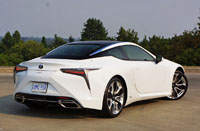
By comparison, the LC could be seen as a runaway success next to the LFA, Lexus’ previous image car. That near-exotic sport model was purposely limited to a mere 500 examples globally over two model years between 2010 and 2012, of which 10 came to Canada. The LC, on the other hand, after launching in 2017 for the 2018 model year, is closer to a sales homerun thanks to seven units driven out of Lexus Canada dealerships last month alone, not to mention nine the month before that. Altogether, Lexus sold 55 LC 500 and 500h models through the first seven months of this year, making it second-to-last for popularity in Japanese premium brand’s arsenal, right next to the last-place LS and its lacklustre 51-unit total. On the positive, the LC was hardly the slowest selling sport/luxury car in the country.
Poorest of the poor goes to the rather rich Maserati GranTurismo, which found just 14 takes this year so far, while this LC also improved on the Acura NSX’ 17-unit tally, plus the Nissan GT-R’s total of 36, and the 54 Audi R8 examples sold. Nevertheless, Mercedes-Benz found 99 SL-Class customers so far this year, while BMW pulled in 160 buyers for its all-new 8 Series, Jaguar attracted 181 newcomers to its latest F-Type, Mercedes wowed everyone with 258 AMG GT deliveries (superb sales for a $170k car), and Porsche won over 587 new clients for its outgoing 2019 911. Interestingly, that last number (587, not 2019 or 911) represented a 31.74-percent downgrade in popularity for the quintessential Porsche sports car when compared to the first seven months of 2018, due to most customers waiting for the completely redesigned 2020 911 that’s now in the midst of arriving.
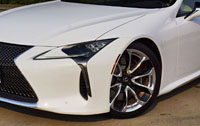
Incidentally, the iconic Porsche wasn’t the only sports car to lose sales, with the R8 plummeting some 70.97 percent, the GranTurismo plunging 48.15 percent, this LC deep diving 48.11 percent, the F-Type caving 29.30 percent, the GT-R pulling back 21.74 percent, and the SL dipping 16.10 percent. The AMG GT was the only car in its glass to gained year-over-year sales, up 55.42 percent over the same seven months, while the new 8 Series will need to wait a year for comparison. I also got a kick out of learning that Lexus’ parent brand, Toyota, found 66 new $65k-plus Supra buyers during the same period.
Of course, other cars compete in this class, but some, such as the BMW i8 and Mercedes-Benz S-Class Coupe, have their sales numbers combined with other models in their respective lines (the i8 paired up with the i3, and the S-Class Coupe with the S-Class Sedan), while the Aston Martin DB11, Bentley Continental GT, and Rolls-Royce Wraith are much pricier models. Blue-oval fans will appreciate hearing that Ford found three customers for its Markham, Ontario-assembled mid-engine GT supercar, while Dodge even pulled in one lucky buyer for its now two-year deceased Viper, and speaking of American supercars, the Corvette pulled in 840 new clients so far this year, and I’m willing to bet the slightly more expensive mid-engine C8 will shortly be flying out of Chevy showrooms, making it even harder for great cars like the LC to gain any sales traction.
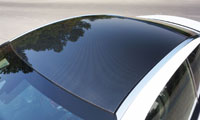
When a car doesn’t gain much popularity, like this LC, I find it a good idea to point out that not doing well on the sales chart doesn’t necessarily reflect its good qualities or bad issues. The way I see it, the very fact it’s a Lexus should bring it respect, and other than the aforementioned fourth-generation LS luxury sedan, which incidentally is only the second model to ride on Toyota’s New Global Architecture or TNGA (specifically TNGA-L or GA-L), the LC is by far the most impressive Lexus ever created.
Its greatest asset has to be its styling. The LC takes the Lexus’ trademark spindle grille to new depths and widths, but the look becomes even more abstract to each corner, with headlights that seem as if they’re alien-implanted mechanical growths, albeit the actual lighted areas are small and filled with threesomes of neatly stacked LED bulbs. All the unusual appendages are just glossy black trim, other than the “arrowhead” daytime running lights just underneath.
More Lexus trademark styling cues can be found toward the rear, with the LC’s C-pillars getting a similar blacked-out “floating roof” design to that found on other models such as the previously noted RX SUV. It’s further adorned with premium polished nickel brightwork, while sharply edged tail lamp prongs closely resemble the so-called “L-shaped” headlights, albeit infused with 80 separate LEDs per corner instead of just three. Lexus shares some of the LC’s taillight design with the previously noted LS sedan, not to mention the iconic Toyota Prius and category topping Camry in its XSE trim line. While each element appears a bit strange on its own, the package on the whole melds together in one wonderfully elegant and intensely attractive whole.
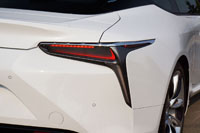
You know something? I almost never comment on styling, unless the design team managed to get something especially right or horribly wrong. Fortunately the Newport Beach, California-based Calty Design Research centre’s team got the LC very right. We can thank studio boss Ian Cartabiano, as well as Edward Lee who was responsible for the sensational exterior design, plus William Chergosky and Ben Chang where were in charge of the interior, albeit not specifically of the LC, but rather the LF-LC Concept that inspired it. The LC was near perfectly transformed from jaw-dropping prototype to equally gorgeous LC 500 and LC 500h production models with hardly a change made to the exterior design, the final result quite possibly the nearest any road-going model has ever resembled its conceptual beginnings.
The production LC’s cabin underwent a total redesign, mind you, although it maintained some of the concept’s general styling cues including its LFA-like pod-shaped digital gauge cluster, its horizontally penned instrument panel incorporating a recessed widescreen centre infotainment display, its driver-centric cockpit that’s partially enclosed by a buttress-type centre console extension that doubles as a front-passenger grab-handle in the production car, the downward-flowing alcantara suede door panels, the deeply bolstered set of front sport seats, the similarly styled sport buckets in back, plus more.
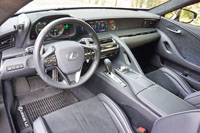
Lexus’ effort was quickly rewarded by the LC’s placement on the WardsAuto 10 Best Interiors list after it arrived in 2017, and I certainly can’t argue against that. It’s a fresh, contemporary design that deliveries big on refinement, luxury and high-tech wizardry, all of which should be expected at its $102,750 starting point in 2019 LC 500 trim, or $103,050 in upcoming 2020 form, or alternatively $118,850 as the 2019 LC 500h hybrid shown on this page, or $118,950 in 2020 LC 500h trim (learn about Lexus LC 500 and 500h pricing right here on CarCostCanada for both the 2019 and 2020 model years, plus find out about available rebates as well as dealer invoice pricing that could save you thousands).
There are no major changes from the 2019 model year to 2020, except for cancelation of the $14,800 Inspiration Series package with Flare Yellow semi-aniline leather upholstery and more for the LC 500, plus a new Bespoke White interior theme that’s also added to the conventionally powered model. All six exterior colours remain the same no matter the powertrain, with Infrared being the sole paint option at $650, whereas all three remaining interior colour themes continue forward as well.
In case you were wondering, Lexus priced my 3.5-litre V6-powered hybrid LC 500h test model higher than the 5.0-litre V8-powered LC 500 version, despite adding 113 horsepower to the eight-cylinder engine, and no doubt providing a more dramatic exhaust note, plus fitting it with a faster shifting, more engaging gearbox than the hybrid’s electronic continuously variable transmission (E-CVT), because of all the extra features that come standard, starting with the regular LC 500’s $13,500 Performance package.
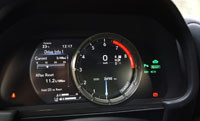
This means that four-wheel active variable gear ratio steering is standard, as is a Torsen limited slip differential, a set o f 21-inch forged alloy wheels on Michelin performance tires (that replace standard 20s), a carbon-fibre roof panel instead of a standard glass roof, an active rear spoiler, carbon-fibre reinforced polymer kick plates, an alcantara suede headliner, more heavily bolstered sport seats, and an eight-way powered driver’s seat in place of the LC 500’s base 10-way design, and lane change assist, which gets added to a comprehensive menu of standard driver assistive technology on both trims including a pre-collision system with autonomous emergency braking, lane departure alert with steering assist, blind spot monitoring with rear cross traffic alert, auto high beams, and adaptive cruise control.
This is a good time to run over a shortlist of standard convenience and luxury highlights, including LED cornering lamps within the triple-LED headlight clusters mentioned before, a tidy little credit card-sized intelligent key for cabin access via proximity sensing, a head-up display unit to go along with the full digital gauge package noted earlier, power-folding outside mirrors, a heated steering wheel that even allows for temperature adjustment, a power-adjustable steering column that connects through to the front seat memory, ventilated front seats (plus, of course, heatable front seats), partially-automated self-parking, etcetera, etcetera.
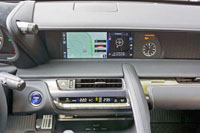
Additionally, a 10.3-inch high-resolution centre display comes standard too, complete with a dynamic guideline-infused backup camera, a navigation system with very accurate route guidance, Apple CarPlay smartphone integration (yes, Android Auto users are out of luck), a brilliant 13-speaker Mark Levinson high resolution surround-sound audio system, satellite radio, two USB ports, traffic and weather information, the Lexus Enform App Suite 2.0 featuring Slacker, Yelp, Sports, Stocks, plus Fuel apps, the Enform Destination Assist app with a single-year subscription, and Enform Safety Connect with Automatic Collision Notification, a Stolen Vehicle Locator, an Emergency Assistance / SOS button, and Enhanced Roadside Assistance with a four-year subscription.
You’d need to stretch a long way in order to touch the centre display, so Lexus doesn’t bother with a touchscreen at all. Instead, the brand’s Remote Touch Interface touchpad gets added to the lower console, and while it works well enough once acclimatized, thanks to some quick-access buttons and audio controls around the touchpad, I can’t say it’s my favourite infotainment system. On the positive, there were many other reasons to appreciate this LC.
For one, it’s pretty large and fairly roomy, at least up front. As noted earlier, it’s based Toyota’s TNGA-L platform architecture, which is the same as the full-size LS luxury sedan, but take note the LC is quite a bit smaller unless measuring width. It spans across an additional 20 mm (0.8 in) at 1,920 mm (75.6 in), and you’ll immediately notice how spacious it is from side-to-side, especially if someone’s sitting next to you. The LC’s wheelbase is abbreviated by 255 mm (10.0 in) to 2,870 mm (113.0 in), however, whereas its nose-to-tail length is a significant 475 mm (18.7 in) shorter, plus it’s nowhere near as tall, the LC lower by 116 mm (4.5 in).
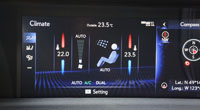
As for how it measures up to its competition, it’s not only a lot smaller than Mercedes’ S-Class Coupe, the LC is actually smaller than the German brand’s mid-size E-Class Coupe too, except for its width. The Lexus comes closer to the BMW i8 and Aston Martin DB11 in overall dimensions, with slightly greater wheelbase, length and height than the shapely German and more exotically branded Brit, but a bit less width this time around.
The LC’s longer length and wheelbase results in a car that can house four adults, but I’d make sure you don’t try to stuff someone too tall into the rear seats. I’m only five-foot-eight with longer legs than torso, but I was forced to kink my neck over to the side in order to fit in, with my head still pushing up against the back glass. The seats are comfortable enough, and I had enough space for my legs and feet, plus my shoulders and hips, which made it a shame that medium-sized adults won’t be able to ride in the rear.
How about trunk space? The LC 500h is smaller than the non-hybrid LC 500, providing just 132 litres (4.7 cu ft) instead of 153 (5.4 cu ft), so therefore you’ll need to stow a second set of clubs in the rear seating area when taking a friend along to the golf course.
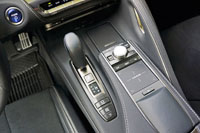
Just in case you don’t fully understand the personal luxury coupe market segment, being able to take more than one set of golf bags to the course that is a critically important make-or-break factor, so it’s quite possible that, together with its lack of rear seat room, LC sales are being hurt by its lacklustre practicality. This Lexus isn’t a pureblooded performance car anyway, particularly in as-tested hybrid form, but instead is a luxurious personal coupe that just happens to ramp up speed quickly and manage corners with deft prowess. This makes the LC more like BMW’s i8 than anything else in the class. It takes off well enough and handles like a well-mannered sports car, but it’s built more for luxury than slaying the cones on weekend autocross course. When it comes to comfort, its suede-like alcantara-clad driver’s seat provides wrap-around comfort and good support all over, while was fully adjustable and complete with ample side bolstering for keeping me in place during aggressive manoeuvres.
Initially I was scheduled for a week in both the LC 500 and 500h, but someone did something naughty to the V8-powered version just ahead of receiving it, so instead of enjoying its 467 horsepower and 398 lb-ft of torque firsthand, not to mention its reportedly quick-shifting 10-speed automatic, I was moved into something else for that week, never to experience the LC 500 at all. Sad as that may be, soon I got into this LC 500h, which is a bit more docile with just 354 horsepower at the rear wheels, but it still felt plenty potent under full throttle.
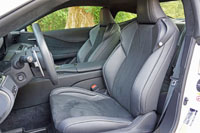
The V6 portion of its hybrid power unit makes just 295 horsepower and 257 lb-ft of torque, which is in fact less than the same engine produces in the Toyota Camry XSE, but before I criticize Lexus for utilizing such a seemingly plebian engine in its most alluring model, consider that a more tautly strung version of this mill makes 430 reliable horsepower in the mid-engine Lotus Evora, so at least it’s in well respected company.
Of course, the lithium-ion battery and electric motor fulfill their torque-rich purpose too, the latter capable of a near immediate 177 horsepower and 221 lb-ft of torque, for a net 472 horsepower and, er, well let’s not even try to calculate its combined internal combustion and electric output, because net horsepower and net torque don’t exactly compute that way. Lexus officially estimates 354 horsepower while other testers are claiming approximately 370 lb-ft of torque. I believe they’re being ultra-conservative, being that the regular V8 shoots from zero to 100km/h in 5.1 seconds and this hybrid takes just 0.5 seconds longer resulting in a sprint time of 5.6, and this is despite the 500h adding 77 kilos (170 lbs) to its 2,012-kg (4,436-lb) curb weight over the 1,935-kg (4,266-lb) 500.
No matter which model you’re driving, make sure to choose the standard Drive Mode Select system’s most entertaining Sport S+ setting, which may not be as edgy as the sportiest mode in one of BMW’s M cars, or Lexus’ own RC F for that matter, but it nevertheless provides higher engine revs between shifts ahead of swapping cogs faster than it otherwise would. Lexus includes a set of large metal steering wheel-mounted paddle-shifters for the latter, which worked ideally in Sport mode as well, but unlike most cars I test I actually kept it in Sport S+ mode more often than not. Along with its increased performance and better feel, the rorty noises emanating from the engine bay and exhaust pipes were downright addictive, particularly when revs rise, and the transmission’s “gear changes” felt considerably more direct.
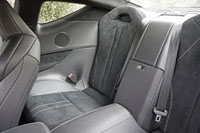
This was one of the most engaging continuously variable transmissions I’ve ever tested, although even factoring in its sophisticated 10-speed Simulated Shift Control technology, which includes a conventional-type multi-gear box within, it can’t completely eradicate all CVT tendencies. Yes, even in its sportiest drive mode its shifts come on so fast between intervals, albeit without the expected positive engagement otherwise experienced in most sport-tuned automatics and dual-clutch automated gearboxes, that it’s almost like nothing has happened at all, plus the V6 makes a habit of whining up and down with the same rubber band effect in between. In a nutshell, if you’re a serious performance fan you’ll want to opt for the V8-powered LC 500, which leaves folks who want to make their environmental mark choosing this hybrid, because let’s face it, anyone paying $100,000-plus for a personal luxury coupe isn’t going to care about saving fuel for the sake of saving dollars.
On that note, the LC 500h’s claimed fuel economy rating is very good for the class, coming in at 9.0 L/100km city, 7.1 highway and 8.1 combined, compared to 15.1 in the city, on the 9.5 highway and 12.6 combined for the regular LC 500.
No doubt the lighter LC 500 aids agility through fast curves when compared to the LC 500h, but either way the long, wide, low and fairly large coupe is a great handler, taking up plenty of real estate yet able to manage corners with precise skill. This is its strength, the LC delivering the same type of relaxed high-speed confidence-inspiring stability found in a big Mercedes-Benz coupe, yet with its own Japanese luxury flair. Its wonderfully balanced chassis is nice and easy on one’s backside too, with ride quality that’s much more comfortable than its large wheels, performance tires, and sporty low-slung design suggests, while its also serenely quiet when the aforementioned driving mode selector is switched from Sport+ or Sport to Comfort or Eco.
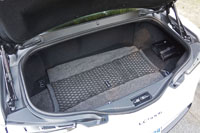
There’s no question whether the Lexus LC is worthy of a premium luxury coupe buyer’s attention or not, but no matter what I think its sales numbers don’t lie. As impressive as this car is, the people have spoken and the result is less than ideal. Even in the U.S., where Lexus is amongst the strongest selling luxury brands, the LC only attracted 764 sales since the January 1, 2019, which slightly better per capita than here in Canada, but nothing to get excited about either. Talk about a new stronger performing LC F model arriving later this year or early next could help pull more eyeballs toward this somewhat forgotten nameplate, as will an stylish new convertible version that’s beginning to be teased online, but who knows? The beautiful LC might just end up as another image-building car that never enjoys much sales traction, good for making Lexus’ well-respected brand name even more desirable, but incapable of making profits on its own.
All said, the LC makes for an especially exclusive example of rolling artwork, which i must say caused more attention from passersby than plenty of pricier cars with more prestigious branding that I’ve driven this year, pulling more long stares, causing more pointing fingers, and resulting in more gaping mouths from astonished onlookers than I was able to count, not to mention an unabashedly overcome German tourist that just had to have me take a photo of him next to it.
Unlike the types of exotic machinery that normally cause such an emotional outpouring, mind you, the LC provides impressively dependable performance as well, which just might be the type of priceless feature that makes owning one worthwhile. If you’d like something undeniably beautiful, that’s also totally unique in the premium marketplace, look no farther than this Lexus LC. Whether suited up in V8-powered 500 or 500h hybrid trim, it’s one thoroughly impressive personal luxury coupe.
Story credit: Trevor Hofmann
Photo credit: Karen Tuggay



